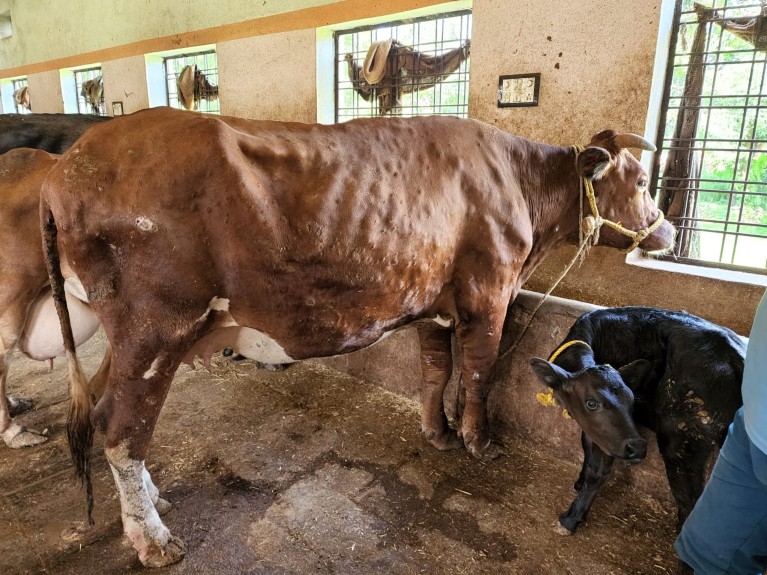
Lumpy skin disease-affected cattle in Rajasthan. Credit: Deepak Sharma
Two strains of the lumpy skin disease virus (LSDV) — one with high genetic variation — caused an outbreak1 of the disease in cows, killing more than 200,000 across India in 2022. The outbreak crippled milk production in the country.
A multi-institutional genetic analysis now offers insights that might help fight the highly contagious virus, first reported in India in 2019. The team found more than 1800 variations in the virus’s DNA genome, including in genes critical for host cell binding, dodging immune response and efficient replication. These mutations allow the virus to reproduce faster, causing more severe symptoms.
Of the two strains, the one with fewer mutations is genetically similar to the LSDV 2019, Ranchi, and 2020, Hyderabad, strains. The other is clustered with LSDV strains from an outbreak in Russia in 2015.
More comprehensive surveillance and data collection are essential to accurately trace these strains' evolutionary pathways and potential multiple introductions because the current global dataset on LSDV genome sequences is limited, says study co-author, Utpal S. Tatu, at the Indian Institute of Science, in Bengaluru.
Tatu is advocating for a vaccine tailor-made for the LSDV variants prevalent in India. Transmitted by blood-feeding insects such as mosquitoes, and ticks, the disease causes fever and nodules on the skin. It was first described in 1929 in Africa. Outbreaks of LSVD were confined to Africa till 1989 after which the disease entered new regions in 2019 — starting with an outbreak in Bangladesh.
The team collected skin nodules, blood and nasal swabs from infected cattle from Gujarat, Maharashtra, Rajasthan and Karnataka, during the August-November 2022 outbreak, in collaboration with veterinary institutes. They carried out advanced whole-genome sequencing of DNA extracted from 22 samples.
India has the highest livestock population in the world and is the largest producer of cow milk. The country’s mass vaccination campaign relies on the goat pox vaccine. The goat pox virus and LSDV both belong to the genus Capripoxvirus and trigger similar immune responses. A Ranchi strain-based homogenous live-attenuated LSD vaccine, Lumpi-Pro VacInd (an experimental vaccine) is likely to be rolled out in a few months, says veterinary virologist, Naveen Kumar, who developed the vaccine and is the Director at National Institute of Virology, in Pune.
“Pox viruses evolve rapidly but they do not lose their integrity. Despite the genetic differences in LSDV strains, they are of a single serotype- they elicit the same immune response which means the LSD vaccine will work against multiple strains,” says Kumar, also a study co-author. Since hot, humid climates support the disease-carrying insects’ reproduction, vaccinations with the LSD vaccine should be carried out before the monsoons, Kumar adds.
